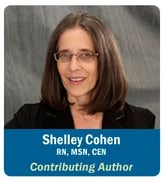Are you prepared for surges in your ED patient volumes?
As we head into the peak of flu season, many facilities are already feeling the effects of increased volumes, such as:
- Longer waiting times
- Staff exposed to more airborne illnesses resulting in increased sick time
- A shift in perceptions of care resulting in lower patient satisfaction scores
 In addition, the Patient Protection and Affordable Care Act (ACA) is expected to result in a surge in patient volume, and there is no way to determine those numbers. Millions of people are expected to enroll in a health insurance plan, many for the first time. Most healthcare professionals anticipate an increased demand on triage, as some of these individuals will assume the "magic" insurance card will cover ED visits for every health issue.
In addition, the Patient Protection and Affordable Care Act (ACA) is expected to result in a surge in patient volume, and there is no way to determine those numbers. Millions of people are expected to enroll in a health insurance plan, many for the first time. Most healthcare professionals anticipate an increased demand on triage, as some of these individuals will assume the "magic" insurance card will cover ED visits for every health issue.
The unpredictable impact on and future of ED/Urgent Care Services as a result of ACA will inevitably place a burden on organizations that are already striving for improved door to physician times to affect better outcomes and patient satisfaction ratings; the increased patient flow has the potential to derail the advances made to date.
The Journal of Health Affairs estimates that more than 30% of physicians will be unwilling to accept the 17 million new Medicare patients, leaving these patients no choice but to access care through the ED or urgent care. The ObamaCare Survival Guide even refers to the ED setting as "back up" for both the newly insured as well as those uninsured by choice.
Given these factors, we recommend you assess your current triage practices and consider the following:
- When was the last time you validated triage competency in the nursing staff?
- Do you have a surge plan in writing that is supported by the administrative team?
- Where are the gaps in triage education, particularly those related to orientation?
- Are staff trained in rapid triage?
- Are your standing orders for triage in compliance with CMS regulations?
 Healthcare professionals need to be realistic and base patient volume surge predictions on historical data about how patients seek emergency care. Despite the fact that the newly insured patients will have access to community health centers and primary care services, it is inevitable that many of them - millions of them - will seek care in emergency departments or urgent care settings.
Healthcare professionals need to be realistic and base patient volume surge predictions on historical data about how patients seek emergency care. Despite the fact that the newly insured patients will have access to community health centers and primary care services, it is inevitable that many of them - millions of them - will seek care in emergency departments or urgent care settings.
A proactive stance will mitigate the challenges - prepare for increasing volumes by providing triage staff with the tools, resources and education required to meet the predicted shift in patient demographics and increased volume.
SOURCES:
Cohen, Shelley. Triage Trainer Update. Hohenwald, TN. Health Resources Unlimited. 2013.
Marco, Catherine, et al. The Ethics of Health Care Reform. Impact on Emergency Medicine. AEM. 19 94;, pages 461-466. 2012.
Tate, Nick. ObamaCare Survival Guide. West Palm Beach. Humanix Books. 2012.


